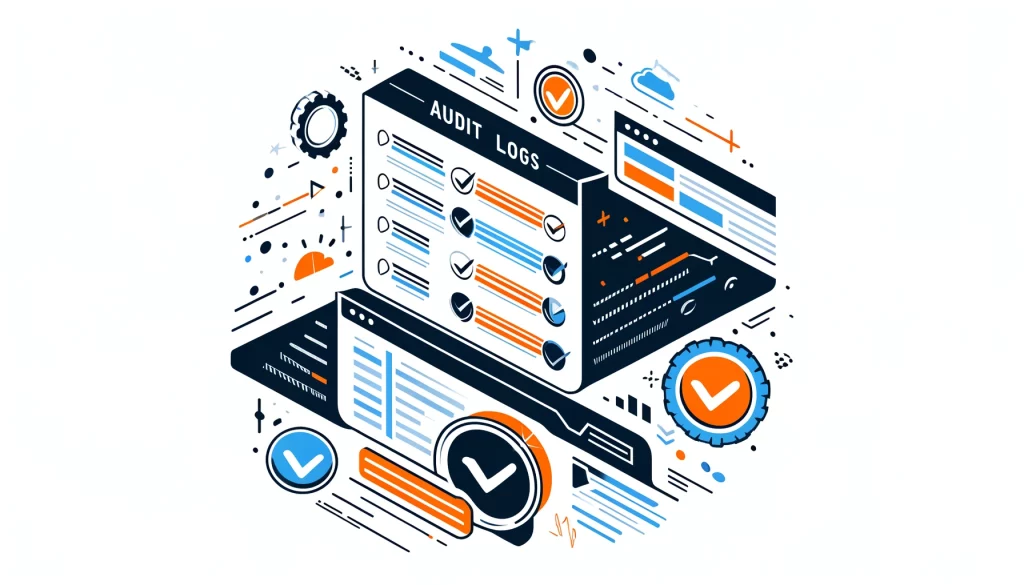
Audit Logs

Audit logs, also known as audit trails, are essential tools for monitoring and securing data within an application. System logs serve as a detailed record of all activities and changes, offering valuable insights into data access, modification, and usage.
They also enable organizations to maintain a high level of data integrity, detect potential security breaches, and comply with various regulatory requirements.
What are Audit Logs?
Audit logs are text files that record events and changes within a system. They are typically stored in a secure location and can be generated by specific processes or monitoring tools.
These logs ensure the proper deployment and operation of a particular process, making them invaluable for regulatory purposes and future performance optimization.
For example, let’s say you have an e-commerce application that handles sensitive customer information.
You can use an audit log to track all actions on the data. This includes updating a customer’s address or adding a new payment method.
This information can be used to detect any suspicious activity and prevent potential security breaches.
Audit logs track all activities in order of occurrence. They show the time and date of each event, the user or system involved, and the specific details of the change.
This detailed information helps organizations understand how their data is being used and changed. This allows them to quickly spot and address any unusual or unauthorized actions.
The Importance of Audit Logs
Audit logs play a crucial role in maintaining the security and integrity of a system. They provide a detailed record of all activities, allowing teams to quickly identify and resolve issues.
During an outage or security breach, Agile software development teams can analyze what happened after the incident. This is also known as a post-mortem. Conducting a post-mortem helps teams understand what went wrong and how to prevent similar issues in the future. It allows teams to learn from their mistakes and improve their processes.
Also, the logs can keep track of how well operations are working. This information can be useful when making changes to the code to improve performance. By analyzing them, teams can identify bottlenecks and optimize their code for better efficiency.
Audit logs also serve as a powerful deterrent against unauthorized access and malicious activities. People are less likely to do bad things when they know they are being watched.
This awareness acts as a deterrent for misconduct. It encourages users to act in a more responsible manner.
Monitoring can help maintain a safe and respectful online environment.
This helps organizations make sure everyone follows the rules to keep things safe and accountable.
In addition to their security benefits, logs are also essential for compliance purposes.
Several industries, like healthcare, finance, and government, must follow strict rules that require them to keep the logs.
These logs show all activities and prove that organizations are protecting sensitive data and following laws.
Types of Audit Logs
The type of activity and change recorded in an audit log depends on its purpose.
A security log tracks who accesses and changes a database. An operation log records the outcomes of changes made to a specific set of data.
Let’s take a look at an example. Suppose you have a financial application that processes transactions. A security log records when a user views the transaction history. It includes the user’s ID, the time of the action, and details of the actions taken.
A log of operations would show any changes made to the transaction data, like converting currency or calculating fees.
Other common types of audit logs include:
- System logs record events like user logins, system configuration changes, and file access related to the operating system.
- Application logs capture events related to a specific application, like user actions, data changes, and error messages.
- Network logs keep track of network activity like incoming and outgoing connections, port usage, and data transfers.
- Access logs keep track of who accesses important resources like databases, files, and applications. They record details like who accessed the resource, when they did it, and what they did.
A thorough audit logging strategy in an IT infrastructure provides a complete view of data and systems. This strategy helps teams identify risks, improve performance, and comply with regulations. This helps them identify risks, improve performance, and comply with regulations.
Best Practices for Implementing Audit Logs
When implementing the logs, there are several best practices to keep in mind. Foremost, it’s essential to store log files in a secure location separate from the system they are tracking. This ensures that if a system is compromised, attackers cannot access the log files and cover their tracks.
It’s important to document and track the variables in templates that are tailored to the specific application. This helps ensure consistency and makes it easier for teams to analyze the logs when necessary.
Other best practices for implementing audit logs include:
- Centralized logging gathers logs from different systems and applications into one central location. This makes it easier to analyze and correlate events across the entire IT infrastructure.
- Real-time monitoring tools can automatically detect suspicious activities or anomalies. These tools can also alert organizations about these issues. This helps organizations respond quickly to potential security incidents.
- Regularly reviewing audit logs can help identify trends, detect potential issues, and ensure that logging mechanisms are working correctly.
- We encrypt log files to keep them secure and prevent unauthorized access. They store them in a secure location that no one can alter. This ensures the accuracy of the information in the logs.
- Creating retention policies for the logs helps organizations in several ways. These policies ensure that we keep necessary data for compliance purposes. They also help manage storage costs and reduce the risk of data breaches.
Companies can effectively set up audit logging systems by using best practices. These systems provide important information about their data and systems. This helps improve security, performance, and ensures compliance with rules.
The Benefits of Audit Logs
Implementing audit logs offers numerous benefits for organizations. They help ensure the security and integrity of sensitive data, prevent potential breaches, and aid in regulatory compliance.
Furthermore, audit logs can be used to optimize application performance, identify bottlenecks, and streamline operations.
For example, let’s say your application experiences a sudden spike in response times. By analyzing the audit logs, you may discover that a particular database query is causing the slowdown.
Armed with this information, you can optimize the query and improve the overall performance of your application.
Other benefits of audit logs include:
- Better incident response: Audit logs show a detailed record of events before a security problem. This helps teams investigate and respond to threats faster.
- Audit logs help organizations keep track of what users do and changes made to the system. This makes sure that everyone follows the rules and procedures.
- Audit logs can help detect fraud by identifying suspicious activities. These activities include unauthorized access attempts and data redaction. These signs may indicate fraudulent behavior.
- Audit logs provide a reliable record of compliance with laws and regulations. This can help prevent costly fines and protect the reputation. Compliance is shown through the detailed information in the audit logs.
- Functional efficiency: By analyzing audit logs, organizations can identify weaknesses in their processes and systems, enabling them to optimize performance and reduce costs.
Audit logs provide valuable insights that help organizations make decisions to enhance security, compliance, and functional efficiency. This leads to a more resilient and successful business.
The Role in Regulatory Compliance
In many industries, such as healthcare and finance, regulatory compliance is a top priority.
Audit logs are important for meeting requirements because they provide a detailed record of all activities done on sensitive data.
For example, HIPAA mandates that healthcare organizations keep thorough audit trails of every time patient data is accessed.
By implementing comprehensive audit logging, these organizations can demonstrate compliance and avoid costly penalties.
The PCI DSS requires organizations that handle credit card transactions to keep records of who accesses cardholder data.
Audit logs help these organizations detect and prevent unauthorized access, ensuring the security of sensitive financial information.
Certain regulations, such as the GDPR and SOX, require organizations to maintain detailed audit logs. These logs demonstrate compliance and protect sensitive data.
Organizations can avoid penalties and build trust by using strong audit logs that meet regulatory requirements. This shows a dedication to data security and privacy.
Conclusion
Audit logs are essential tools for tracking critical operations, ensuring data security, and optimizing application performance. By implementing comprehensive audit logging, organizations can protect sensitive data, meet regulatory requirements, and gain valuable insights into their systems. It is important for system administrators, DevOps engineers, and InfoSec professionals to understand audit logs. Audit logs help ensure the integrity and efficiency of applications.
Audit logs are essential for maintaining the security, compliance, and performance of applications, especially as data volume and complexity grow.
Organizations can be proactive by investing in audit logging mechanisms. This will help them identify and address potential threats early on. Additionally, by following best practices for implementation and analysis, organizations can optimize their operations. This will allow them to build a strong foundation for long-term success in the digital age.
